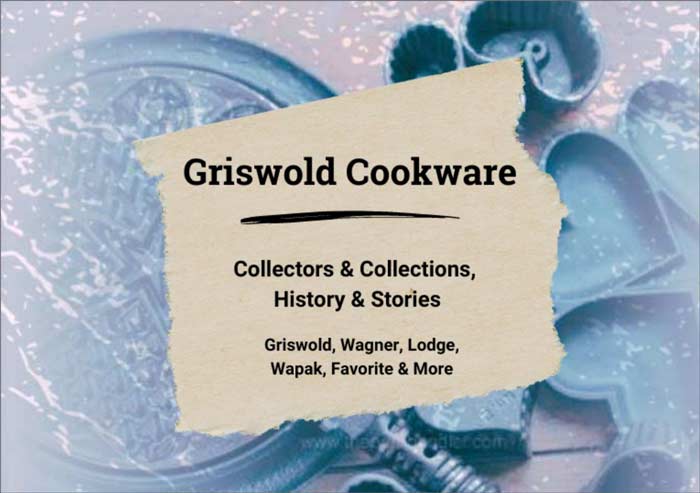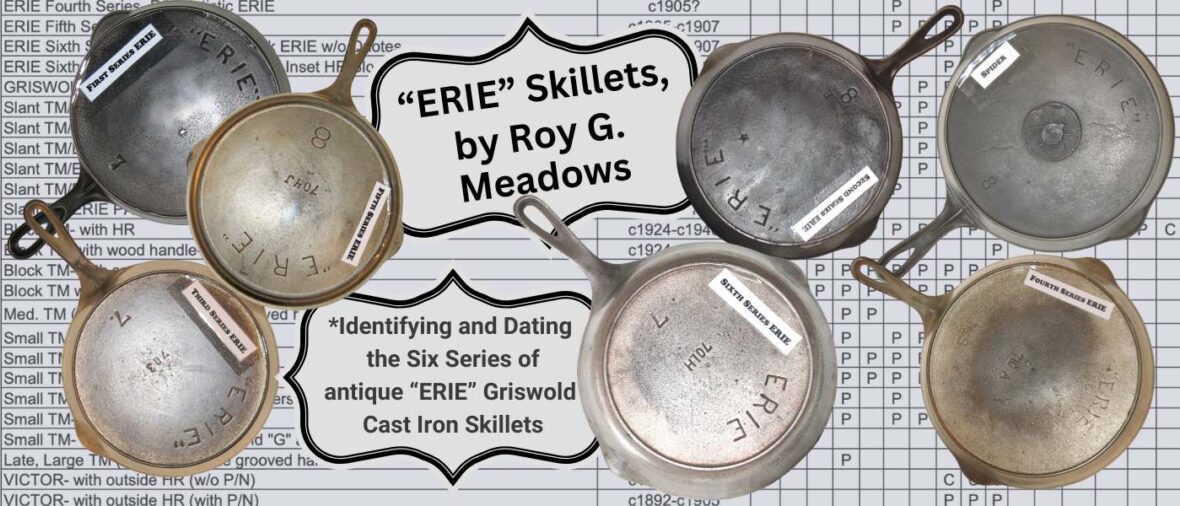By Roy G. Meadows, as updated March 17, 2025
Foreword
by Mary Theisen
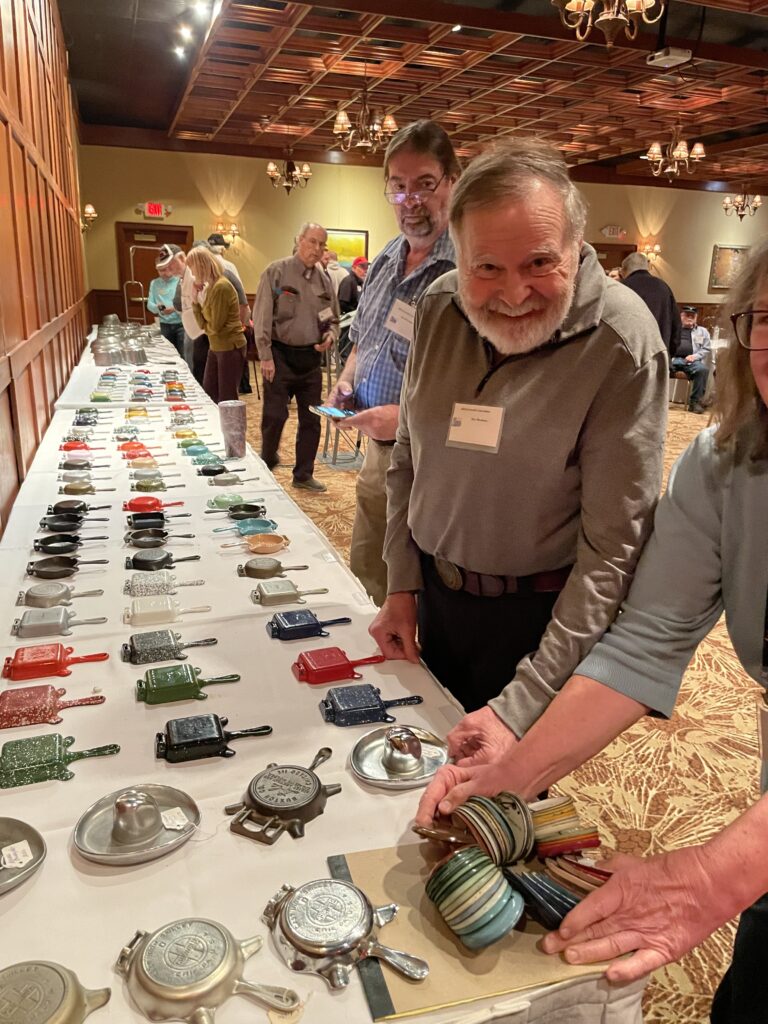
On March 17, 2025, I had the opportunity to interview Roy G. Meadows.1 Mr. Meadows is well-known in the cast iron collecting community for his expertise and extensive knowledge–particularly of antique “ERIE” cast iron skillets, which were produced in Erie, Pennsylvania by the Griswold Manufacturing Company and its predecessor, Selden & Griswold.
Mr. Meadows wrote a very thorough and well-researched article about ERIE skillets in 2009, which he updated in 2016. He made another update on March 17, 2025 to add two pieces of information: a pattern-makers mark (4-leaf clover) and pattern number 708 to the Third Series ERIE skillet.

The Meadows article provides a comprehensive overview of antique “ERIE” cast iron skillets produced by Selden & Griswold and the Griswold Manufacturing Company, from around 1880 to 1907. It highlights the distinguishing characteristics of these early skillets and categorizes them into six different “Series.” The renowned “ERIE” spider skillet is also addressed. The article includes photos to assist readers in identifying the unique traits of each Series. Additionally, it identifies twenty-nine pattern-maker marks found on some of the Second and Third Series “ERIE” skillets.
The Meadows article is reprinted in this post in its entirety.2 As he mentioned to me, his goal is “to provide the best, most accurate, and most complete information to collectors and others who are interested. If I learn something new, I’m always eager to share it.”
He has kindly agreed to allow me to share his most recent article version with you.
This article reflects hundreds of hours of research, analysis, and effort by Roy G. Meadows. It is both comprehensive and highly valuable to the cast iron collecting community. Should you re-post or re-use any portions of his article or photos, do him the courtesy of recognizing his work and giving him credit.
“ERIE” Skillets
Roy G. Meadows, as updated March 17, 2025
Griswold Manufacturing Company or its predecessor Selden and Griswold Manufacturing Company produced “ERIE” skillets for 27 years from c1880 to c1907. Along the way there were significant changes made to the skillets. These changes can be captured as identifying characteristics and can be categorized into six discrete Series.
A primary objective of this article is to assist collectors in the identification of “ERIE” skillets in each Series.
About 1886 Selden and Griswold started producing the less expensive VICTOR line of skillets. Many characteristics of the VICTOR’s match or correspond closely to those of their “ERIE” line.
BACKGROUND AND METHODOLOGY
While it has been said that almost every “ERIE” skillet is different or individualized, if one studies many, many “ERIEs,” the defining characteristics begin to sort themselves into different groups or Series. A progression in the development of the “ERIE” skillet can be noted, and approximate dates can even be assigned to various changes.
The work that is being summarized here is that of W. Dean Fitzwater, John Madole, Steve Stephens, and Roy G. Meadows. Although W. Dean Fitzwater in Kettles ‘n Cookware, Vol.4 No.6, published in February/March 1996, first reported on this topic, the above individuals along with others have been studying the “ERIEs” for several years.
The work reported by Fitzwater in 1996 only recognized five Series of “ERIEs.” The very earliest “ERIEs,” with the “scooped handle,” were not even recognized at this time. John Madole reported on this early Series, which he called the “New Series,” in a Kettles ‘n Cookware article in Vol.10 No.6 published November/December 2001. This additional Series has been put in the proper sequence and is now called the First Series. The other Series were subsequently renumbered and this resulted in the six Series we identify today.
IDENTIFYING CHARACTERISTICS OF THE SIX SERIES
This section will include a brief discussion of the identifying characteristics for each of the six Series. It will enable one to place a particular “ERIE” skillet in the proper Series.
First Series (c1880-c1886)
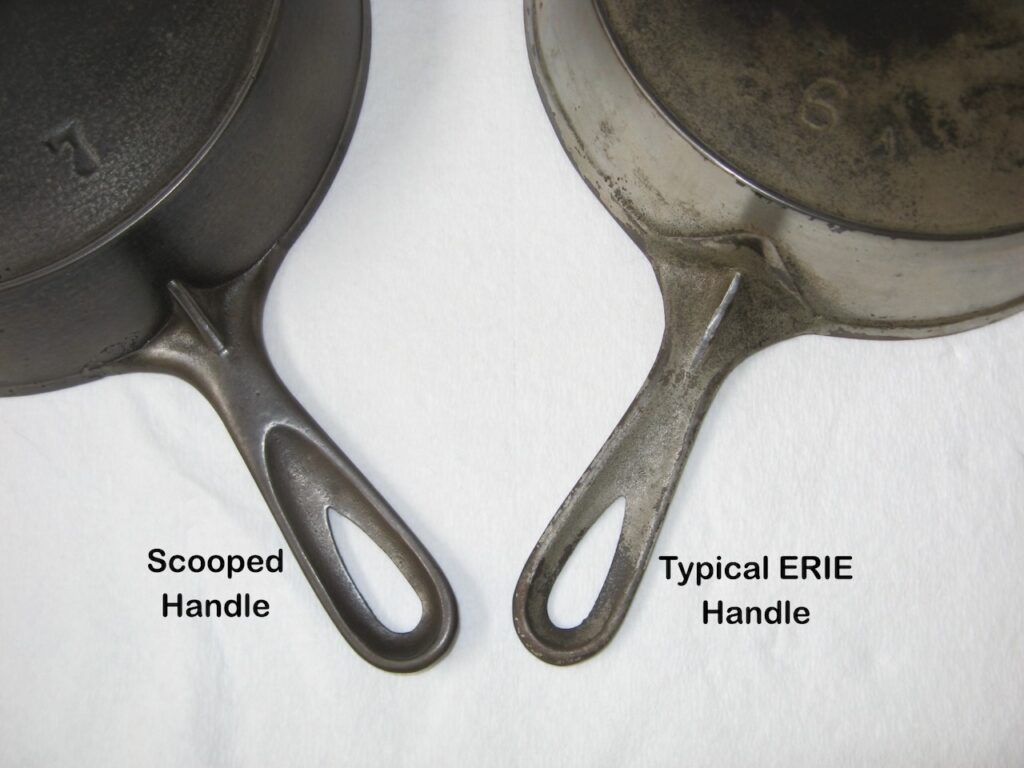
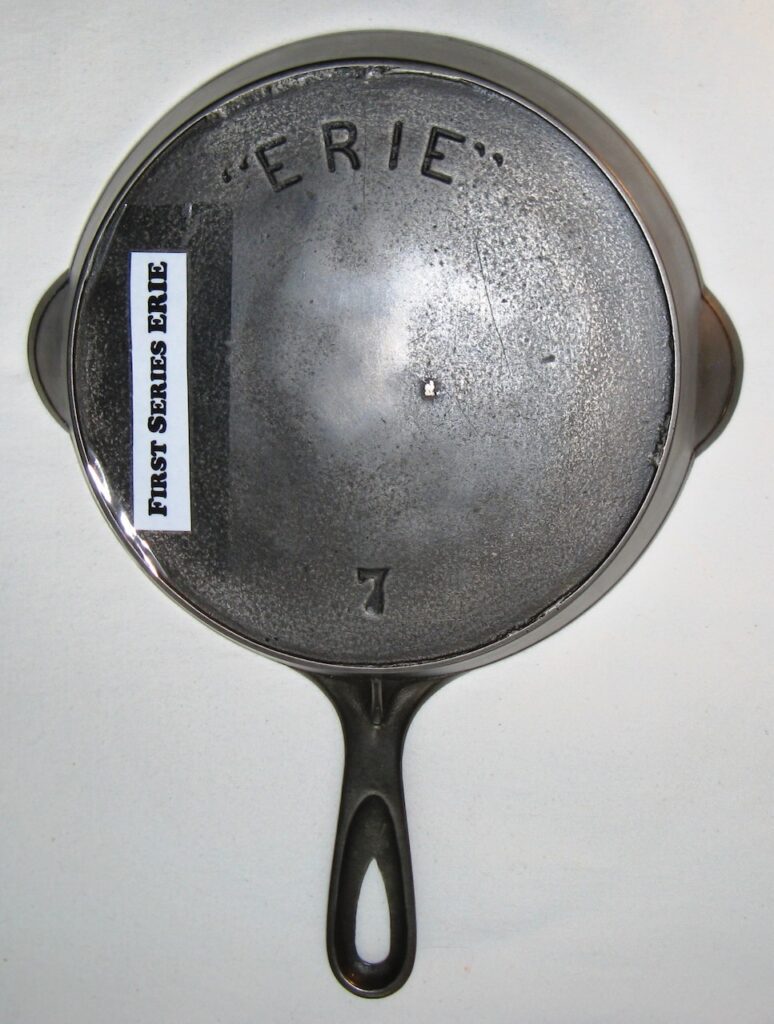
The earliest “ERIEs,” which we call the First Series, have outside heat rings with the identifying characteristic “scooped handle.” The underneath portion of the handle around the teardrop hole resembles a “scoop.” See the comparison of a “scooped handle” to a handle typical of the other “ERIE” Series in Figure 1. This area for gripping with one’s fingers has a distinct recess for the First Series while this area blends into the handle for the other Series. The First Series skillets did not have pattern numbers. Figure 2 shows a typical First Series “ERIE.”
Second Series (c1886-c1892)
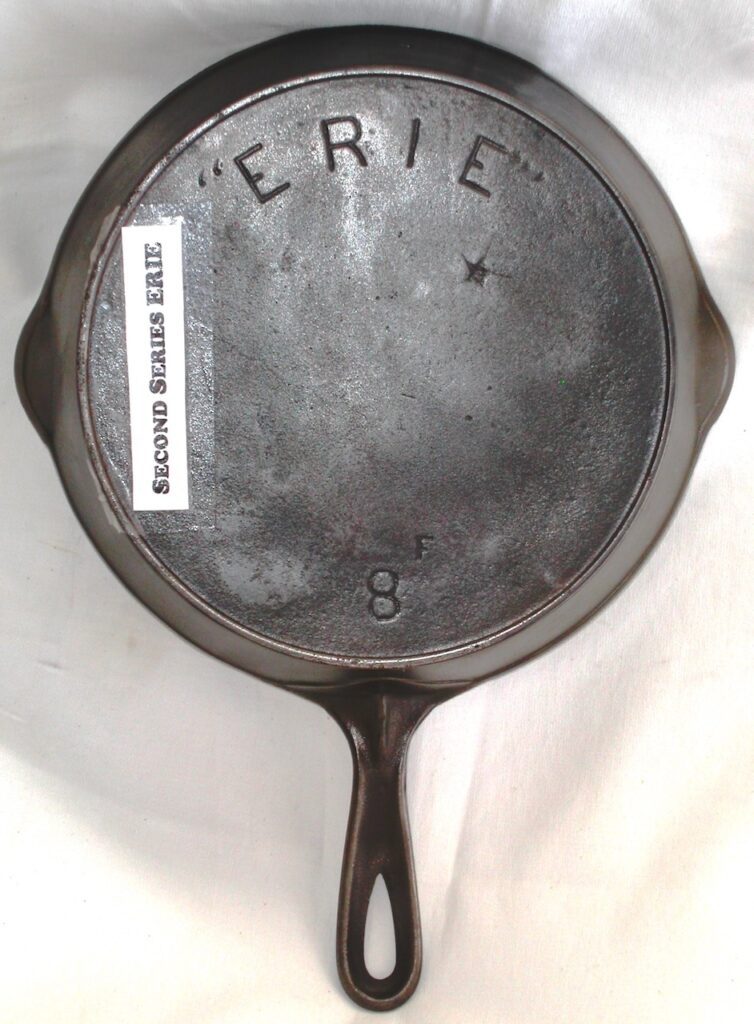
The identifying characteristics of the Second Series, which also has outside heat rings, are the lack of a pattern number along with a ribbed handle rather than the “scooped handle.” The rib handle may be of the modified or medium type (i.e., partial) or it may be the full rib type extending to the tip of the hole. The ribbed handle came after the “scooped handle,” but still, there was no pattern number, just as with the First Series. See Figure 3 for a typical Second Series “ERIE.”
Third Series (c1892-c1905)
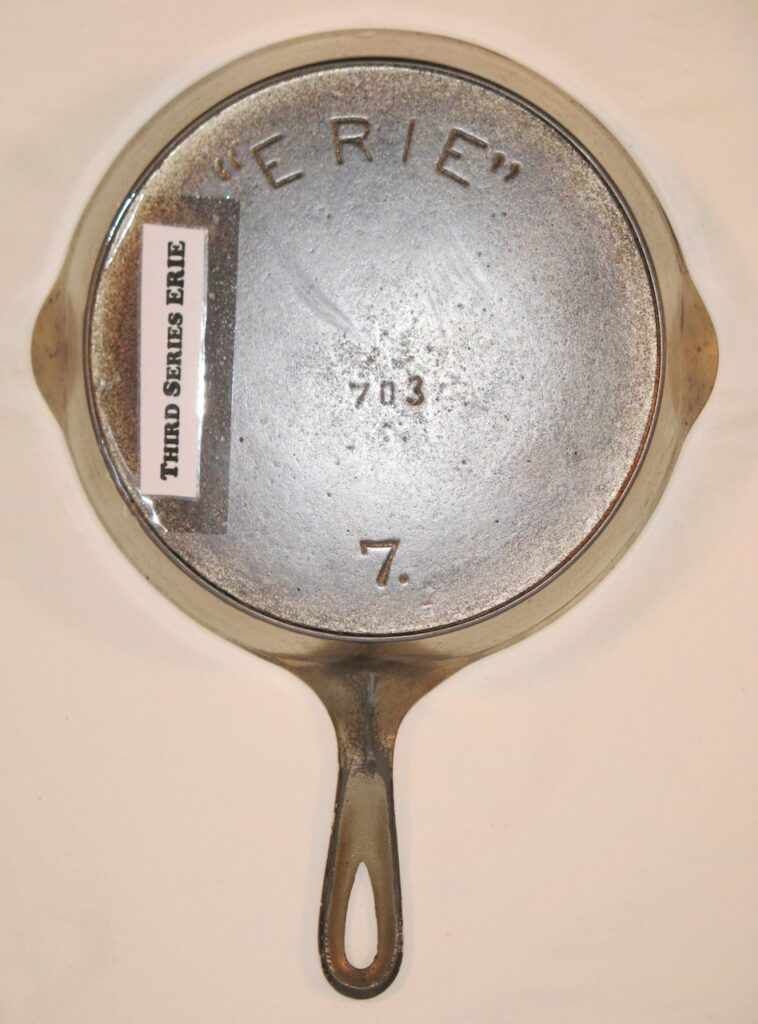
In about 1892 Selden and Griswold Manufacturing started putting pattern numbers on their cookware. The identifying characteristic for the Third Series is skillets with outside heat rings, rib handles, and also with pattern numbers. These pattern numbers were located in the center of the skillets. See Figure 4 for a typical Third Series “ERIE.” This “ERIE” Series had the longest production time of about 13 years. Therefore, there exists more Third Series “ERIEs” than any of the other Series.
Fourth Series (c1905?)
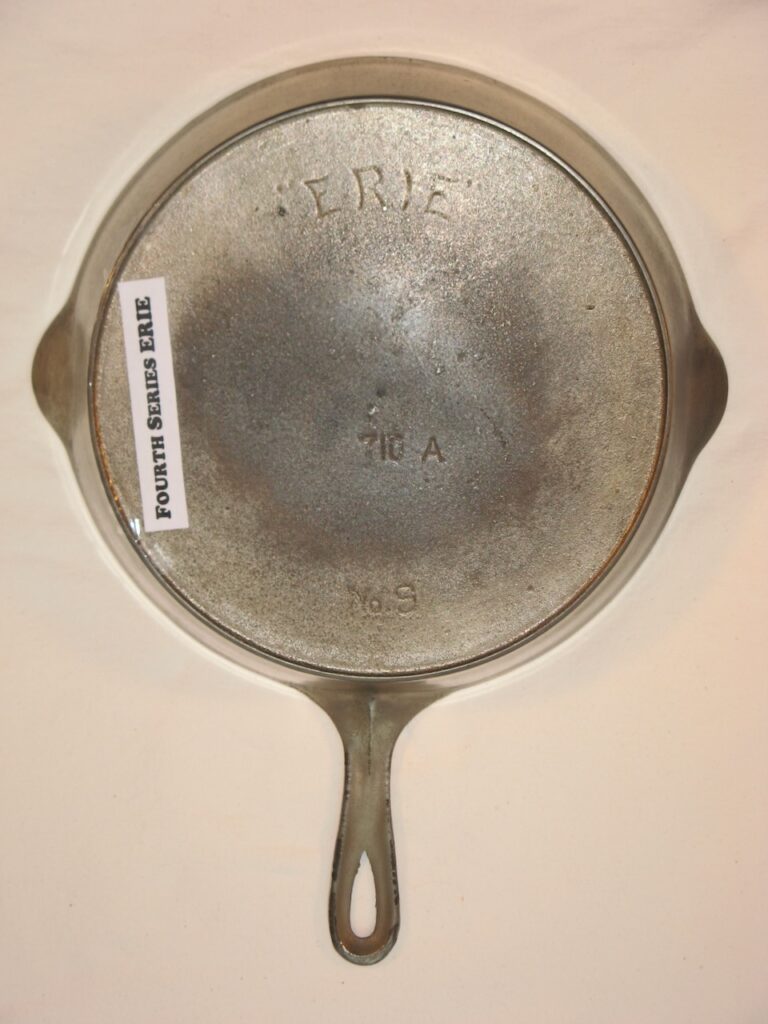
For a short duration believed to be in 1905 after moving into a new and larger plant, Griswold produced skillets with the identifying characteristic of the lettering being of an artistic style. Prior the lettering had basically been of a block nature. This Series was made with both the outside heat ring and the new inset heat ring. See Figure 5 for a typical Fourth Series “ERIE.”
Fifth Series (c1905-c1907)
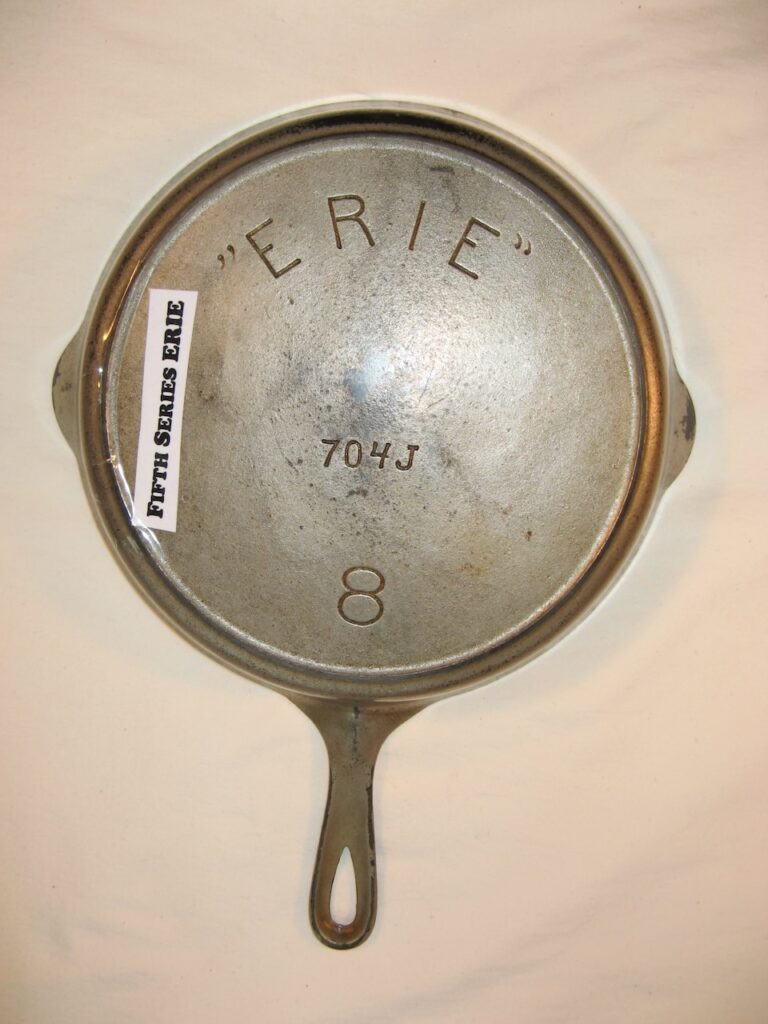
The Fifth Series returned to the traditional block lettering in quotes, but with the distinguishing characteristic of having an inset heat ring. See Figure 6 for a typical Fifth Series “ERIE.” This is the first Series to be produced in all sizes 5 through 12. It was during this period that Griswold identified one specific pattern number for a given size skillet and this number was followed throughout the remainder of Griswold’s existence to 1957.
Sixth Series (c1905-c1907)
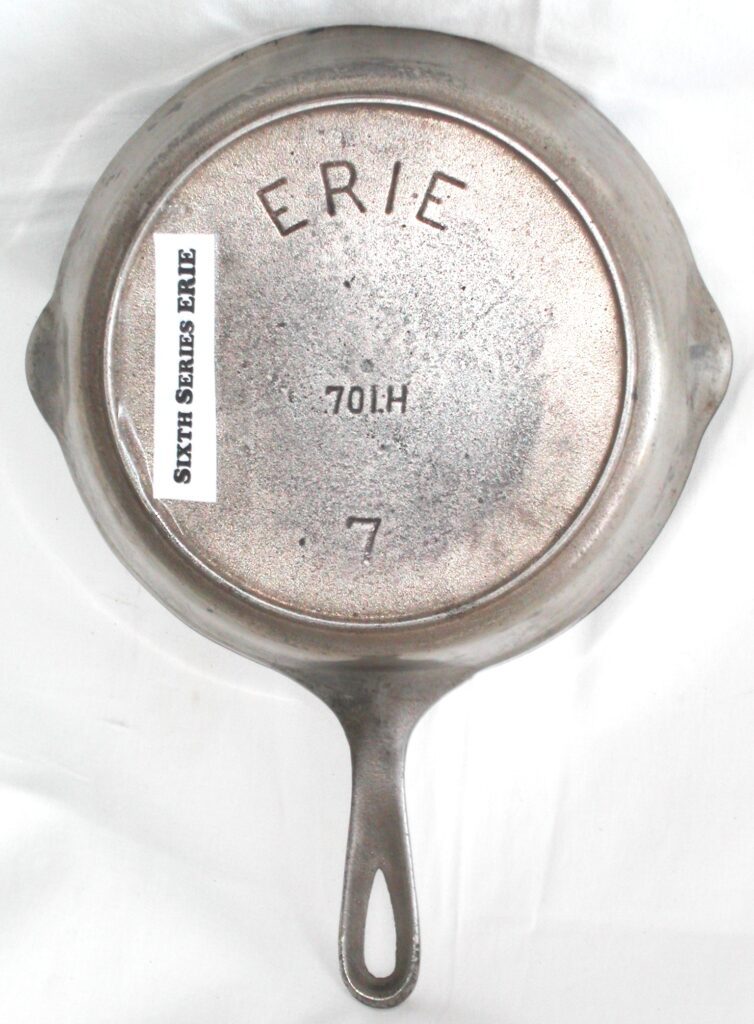
The identifying characteristic for the Sixth Series inset heat ring skillets is the omission of quotes around the ERIE trademark. The quotes were omitted for the remaining skillets that Griswold produced. See Figure 7 for a typical Sixth Series ERIE.
Spider (c1890-c1891)
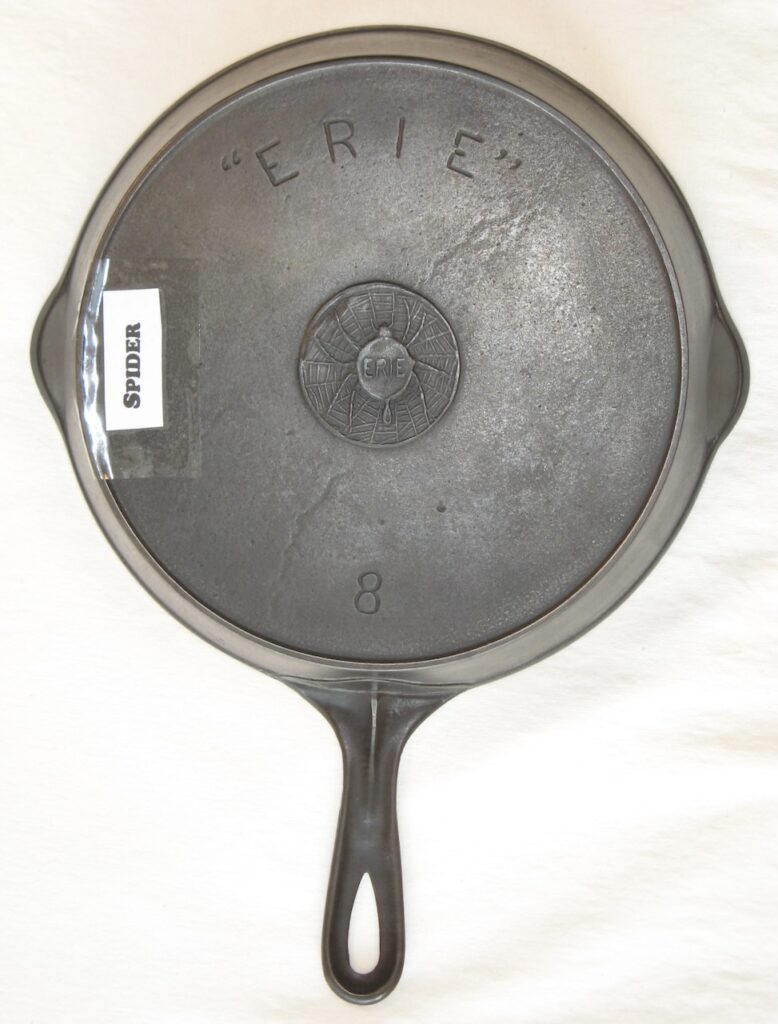
Not much is known about the reason why Griswold produced the “ERIE” Spider. It can be dated about c1890-c1891 by analyzing the characteristics or features of the skillet. Was it produced for a special event, as a commemorative item, or did it fall from favor due to the “spider” logo? Perhaps many housewives didn’t like having a “spider” in their kitchen. The reason is not known. The design was not particularly durable in that the Spider logo is a positive (protrudes from the base) and was therefore worn off easily as the skillet was moved around on the stove. Was this the reason for its short life? Figure 8 shows a typical “ERIE” Spider. The Spider is treated as a special edition skillet although we know it was made during the “ERIE” era.
We know the “spider” logo or trademark was a favorite with Griswold management, and it was used in their company letterhead for many years after it was no longer used on their skillets and teakettles. We have seen examples of letterhead used by Matthew Griswold as late as 1908 that still uses the “spider” logo or trademark.
The “spider” logo is believed to have originated from the story about Robert Bruce (1274-1329), a gallant Scottish king who spent most of his life trying to free his country from English rule. The legend is told about Bruce lying in a bed in a wretched hut hiding from his enemies. On the roof above him, Bruce saw a spider swinging by one of its threads. It was trying to swing itself from one beam to another. It tried six times and failed. Bruce realized that he had fought the same number of battles in vain against the English. He decided that if the spider tried a seventh time and succeeded, he also would try again. The spider’s seventh attempt was successful. Bruce took heart and went forth to victory.
The following is from a 1904 The Griswold Mfg. Co. Bulletin A showing the “spider” logo or trademark along with this quote:
As the little spider brought success to Robert Bruce, so cooking utensils bearing this trade mark brings success to all who use them.
DISCUSSION OF OTHER CHARACTERISTICS AND PROGRESSION
The features or characteristics of the six “ERIE” Series have been summarized in Figure 9, “ERIE” Chart of Characteristics. This can be used as a quick reference to help identify a skillet as being in a particular Series. This also provides the approximate date of manufacture. This section will discuss the various characteristics, aid in their identity, and discuss their progression.

“ERIE”
The “ERIE” name or trademark appears in quotes on the First through Fifth Series. Only on the Sixth Series has the quotes been omitted. The Sixth Series was probably the transition to eliminating the quotes around the name (either “ERIE” or Griswold) used in the trademark. Quotes were not used in any Griswold skillet trademarks subsequent to the “ERIEs.”
The size and spacing of the letters used to comprise the word “ERIE” varied not only from Series to Series, but also within the Series even for the same size skillet. The lettering appears to have become more standardized after the Fourth Series.
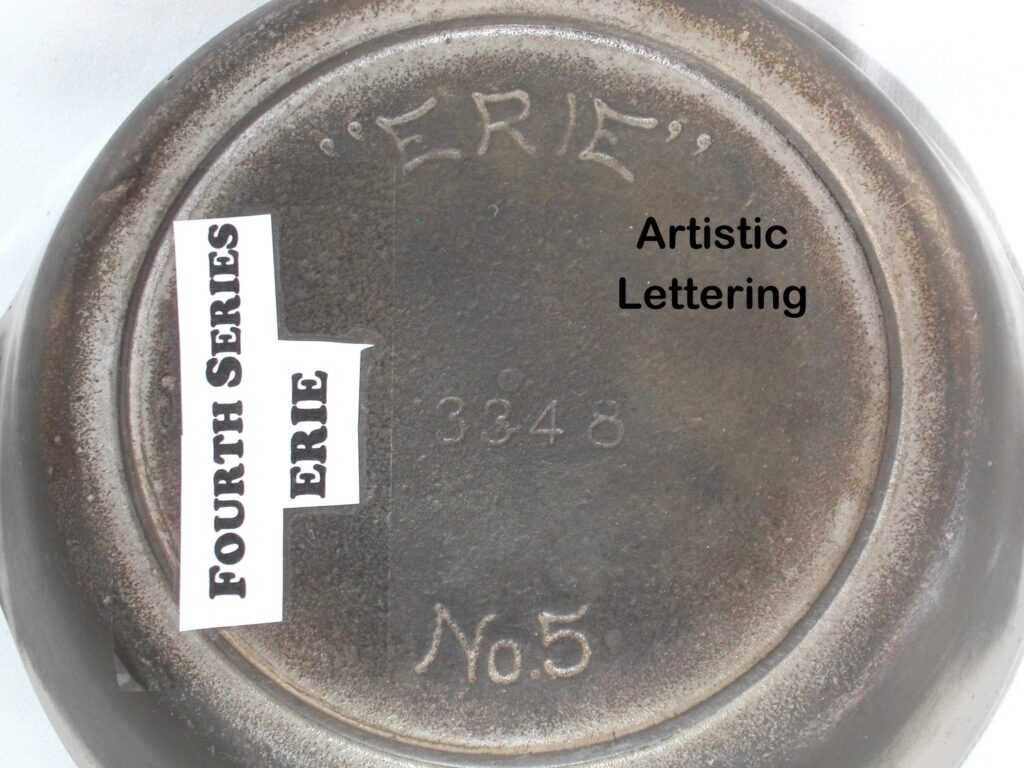
The letters in the Fourth Series are unique and have been referred to as Artistic lettering. It has also been described as “squiggly” lettering. See Figure 10 for an Example of the Artistic Lettered, Fourth Series. The reason for this type of lettering is not known, and it was used for only a relatively short period, as can be surmised from the low number of Fourth Series “ERIEs” that are found.
Heat Ring
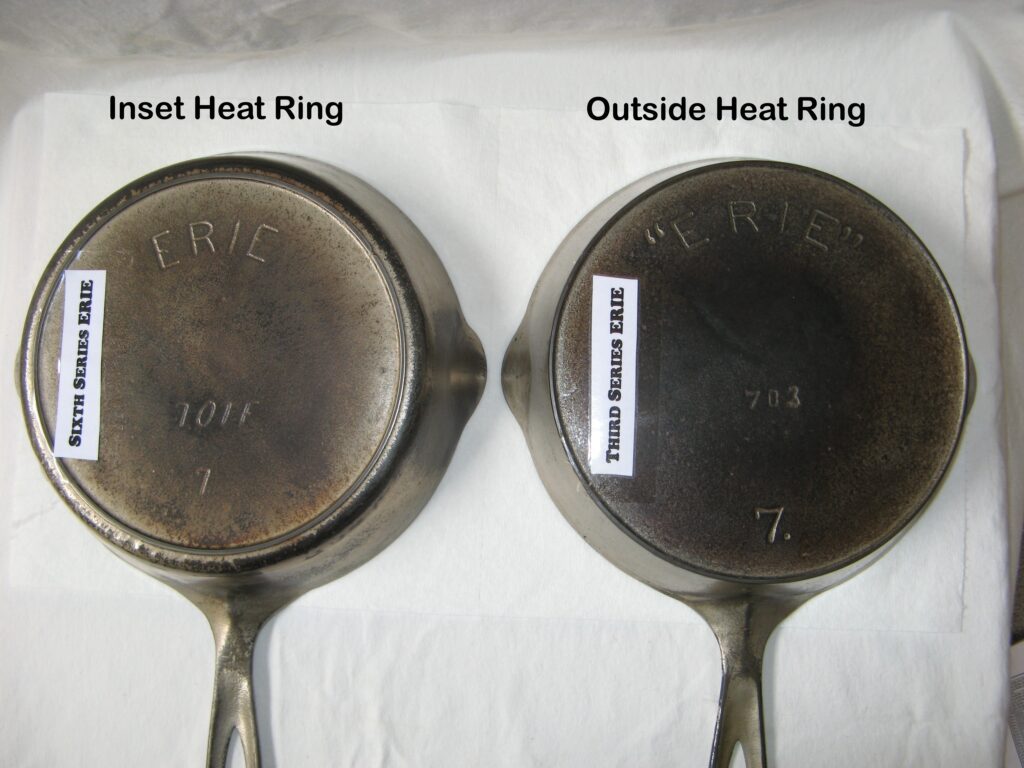
The transition was made during the production of the Fourth Series “ERIE’s” around 1905 from the Outside Heat Ring to the Inset Heat Ring that was used for all future skillets. The Outside Heat Rings were on the edge of the bottom and were basically extensions of the skillet sidewalls. They protruded about 1/16 inch below the bottom. See Figure 11 for a Comparison of the Types of Heat Rings.
It is believed the Heat Ring was used for two purposes. First, it provided even heat distribution. With the skillet sitting on the Heat Ring, the cooking surface did not touch the smooth surface of the wood stovetop and therefore hot spots were eliminated. The raised bottom allowed heat to circulate equally under all parts of the skillet; much of the heat was transferred by convection rather than by conduction. Second, if a skillet bottom warped slightly from the heat, the skillet would still sit flat on its Heat Ring on the smooth stovetop surface. It is felt that even with the introduction of smooth bottom skillets with their thicker bottoms, Heat Rings continued to be used on the larger sizes (11-14) because the large bottoms are more prone to hot spots and warping.
The Heat Rings also tended to keep the skillets centered on certain types of burners such as a wood stove when used without the cook top lid or an electric stove with a round eye.
The Inset Heat Rings give better support to the bottom of the skillet by reducing the width of the span. Therefore, skillets with Inset Heat Rings are less likely to warp and this is felt to be the reason for the change from Outside to Inset Heat Rings.
Pattern-Maker Marks
Many of the Second and Third Series “ERIE” skillets had small figures or extraneous letters or numbers that are believed to be marks to identify a particular pattern and perhaps the pattern maker. Thus they are called Pattern-Maker Marks. Twenty-nine different symbols and seven different letters and numbers have been identified and are shown in Figure 12. There may be others that have not yet been identified. Some of the symbols are very interesting and are much sought after by several collectors.


Note that the letter following the pattern number on the Third and higher Series skillets is not considered to be a Pattern-Maker Mark. The real purpose for this letter is not certain, but the following are possibilities:
- Indicator of pattern position when casting multiple pieces in the same mold
- Pattern designation or identification number, or
- For quality control purposes.
Pattern Number
Beginning with the Third Series in about 1892, pattern numbers were assigned for each skillet. It is thought that initially a separate pattern number was assigned for each pattern. However, with time and significant use patterns wear out. So assigning a separate number soon became impractical due to the sheer number of patterns required for a run of several years for a particular skillet of a particular size. For this reason one specific number was assigned for each size skillet starting with the Fifth Series. The same number was used for a particular size skillet for the remainder of Griswold’s production until they stopped in 1957. Although the trademark would change (i.e., Slant, Large Block, Small Block, etc.), the pattern number would remain the same. Figure 9 shows the pattern numbers used for the Third, Fourth, Fifth, and Sixth Series “ERIEs.”
All of the pattern numbers are three digit numbers except for the No. 5 in the Artistic Fourth Series. For some reason not understood a four-digit number, 3348, was used on a portion of the production. Both the pattern numbers 724 and 3348 can be found with the Inset Heat Ring. Another unusual occurrence with the Artistic Fourth Series skillets is that the abbreviation “No.” was used before the skillet number. This abbreviation was not used on any other Series. This abbreviation can be seen on the skillet in Figure 5.
Reinforced Lip
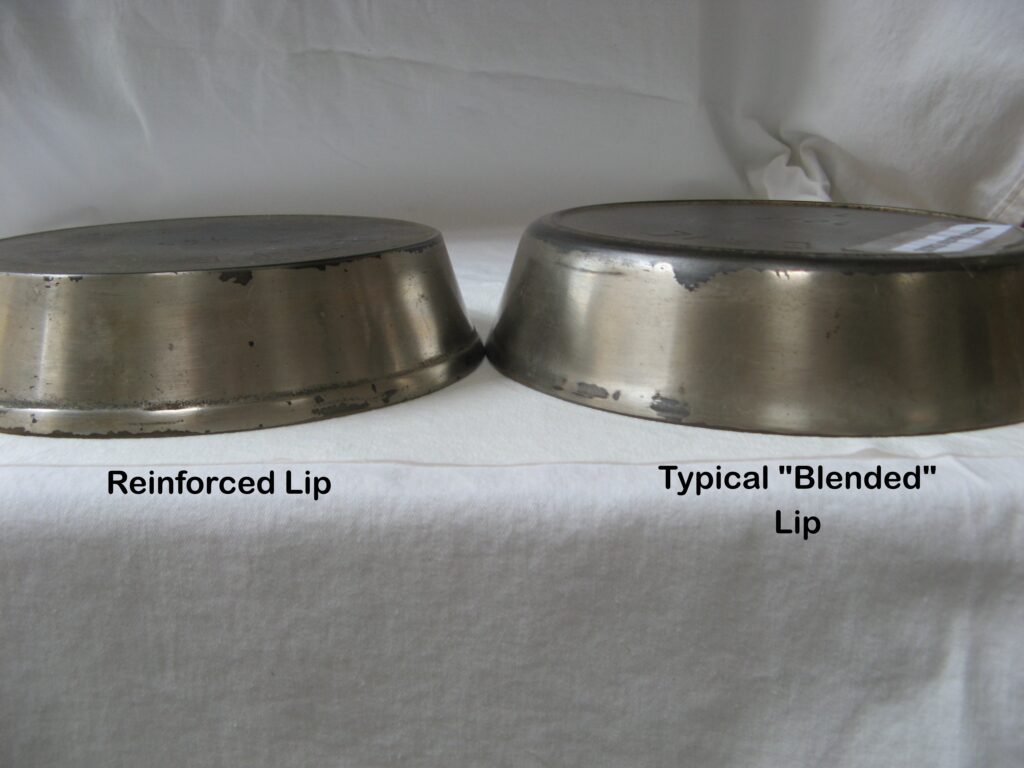
The lip of the “ERIE” skillets was made thicker than the skillet sides. This reinforcing was probably done to make it stronger and less susceptible to cracking. Although the lip is thicker on all “ERIE” skillets, a very distinct lip is found on the First, Second, and some of the Third Series. Starting with the Fourth Series the thicker lip is “blended” into the skillet side. See Figure 13 for a Comparison of Skillet Lips. In some articles this distinct reinforcing lip of the early Series was referred to as a Wrap Lip.
Handles
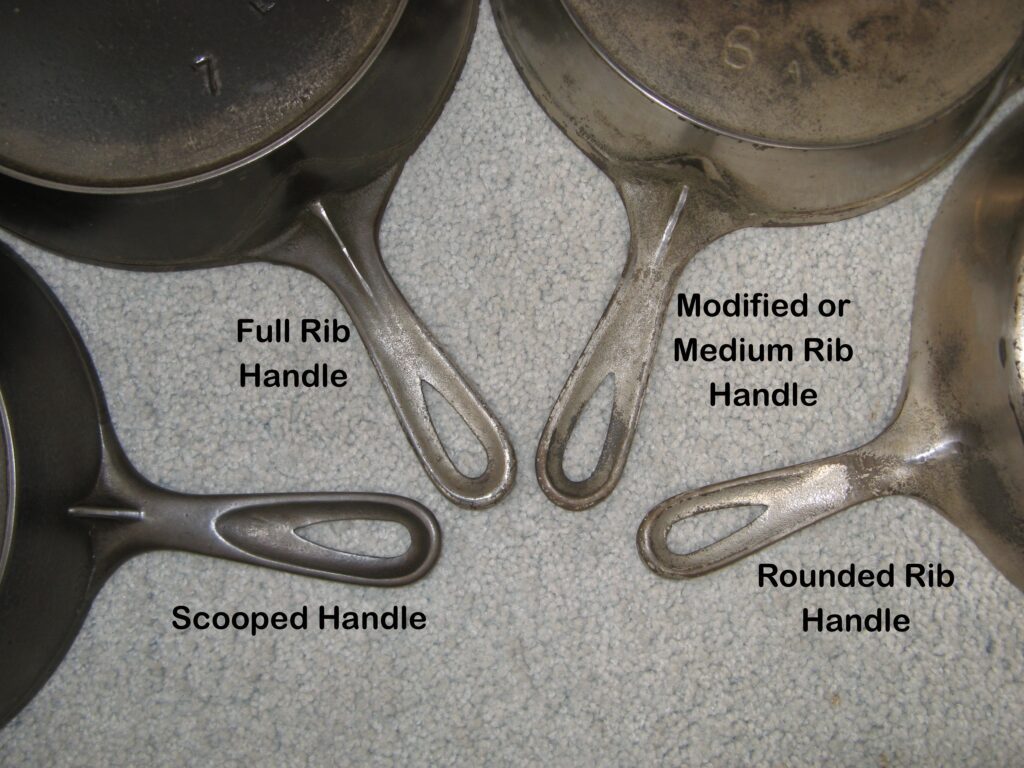
Several different shapes were used for the handles on “ERIE” skillets. As already discussed the First Series had the “scooped handle.” This evolved into a Full Rib Handle, then a Modified or Medium Rib Handle, and finally into the Rounded Rib Handle used in their later production. See Figure 14 for a Comparison of Handles.
Reinforcing Pads
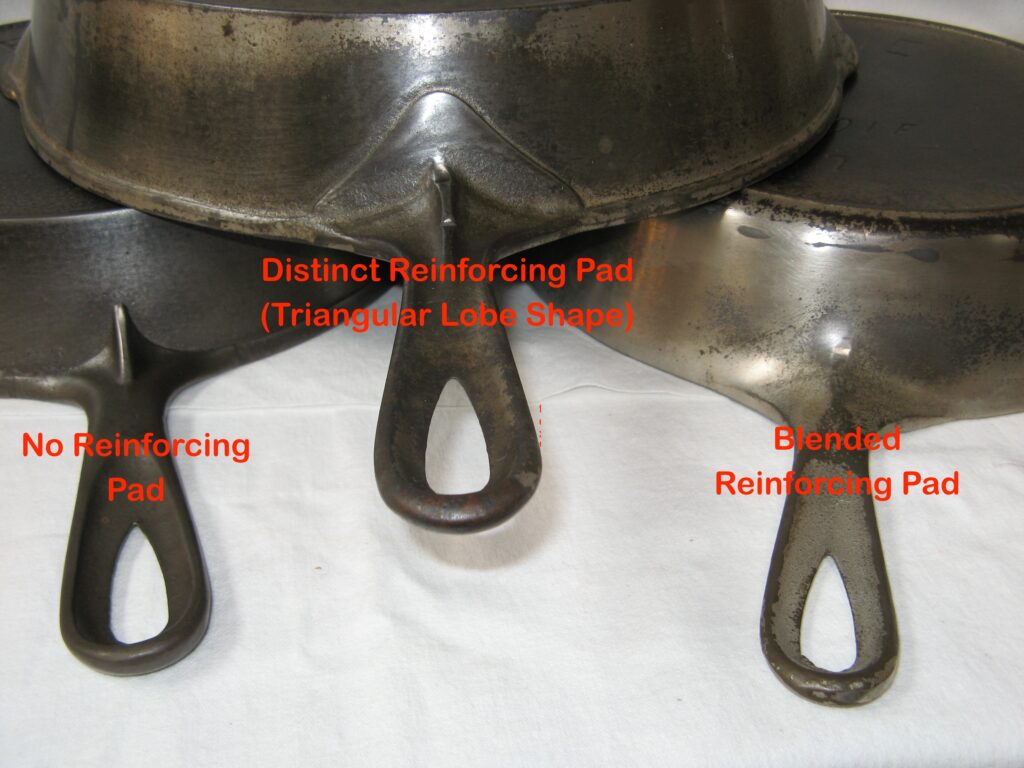
Except for the initial First Series skillets, all “ERIEs” as well as Griswold’s later production had reinforcing pads where the handle is attached to the skillet wall. This reinforcing pad is rather distinct on a portion of the First and Third Series skillets and all of Second Series skillets. Starting during the run of the Third Series this reinforcing pad was blended into the side of the skillet so its presence is not as noticeable. The Distinct Reinforcing Pad had several shapes ranging from a semicircle or half-moon, to a half-moon with semi-rounded sides, and finally to the familiar triangular lobe shape. See Figure 15 for a Comparison of Reinforcing Pads.
It is obvious from looking at the progression of the changes being made to the handle and reinforcing pad as the “ERIEs” evolved that issues arose around this junction that Griswold was trying to overcome. Cracking was a big problem both in manufacturing and during use by the housewife. The reinforcement was finally blended into the skillet side to prevent the concentration of stress forces at the edge of the Distinct Reinforcing Pad.
Plated Skillets
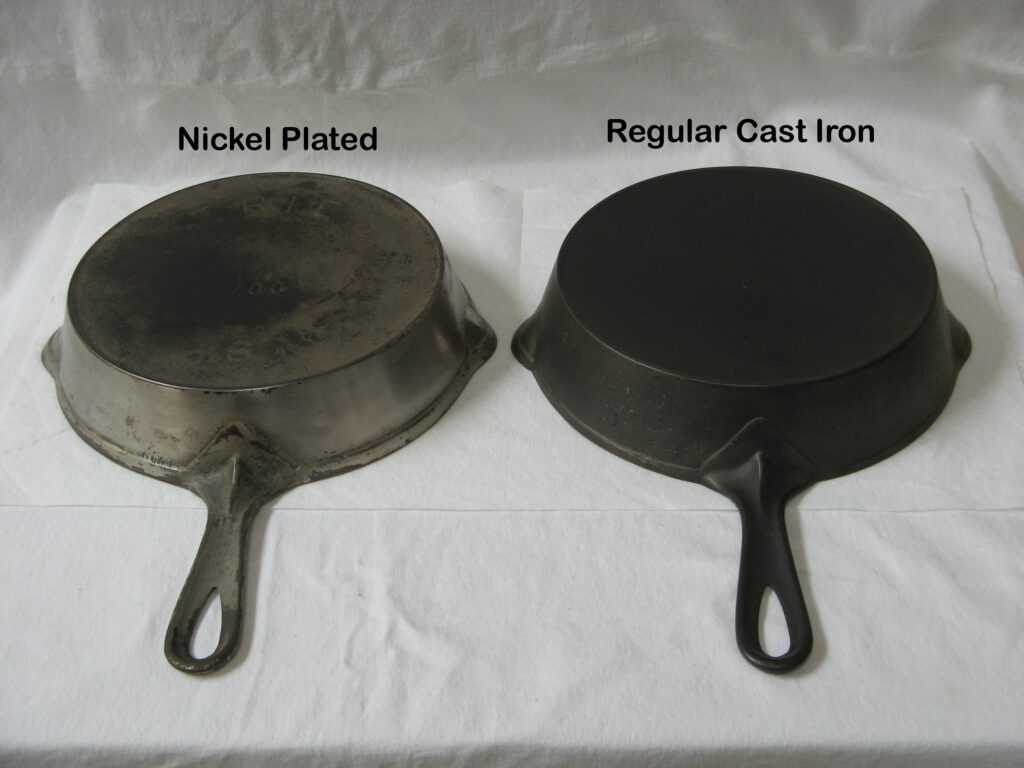
Selden and Griswold started nickel-plating skillets in c1890 or c1891. This was during the production of the Second Series “ERIEs.” Nickel plated “ERIEs” can be found in all Series except for the First Series. Commercial nickel-plating, which used electricity, was relatively new when first used by Griswold. It seems there was a demand for cooking utensils that looked “better” than regular cast iron by their wealthier customers. The plated utensils were shiny and were advertised to have a superior cooking surface. They would generally command a price that was double that for the identical regular cast iron utensil. See Figure 16 for a typical Nickel Plated “ERIE.”
All plated “ERIEs” were nickel-plated; Griswold did not start plating with chromium until c1929.
Skillet Sizes
In general “ERIEs” were manufactured in sizes 6 through 12 corresponding to the common burner or cook lid sizes for wood stoves. The small (0 through 5) and large (13, 14, and 20) size skillets came after the production of “ERIEs” had stopped.
The smaller sizes of the First Series “ERIEs” had smaller dimensions than for the corresponding size in the other Series. This is probably the reason a size 6 was not made in the First Series. The No. 7 skillet would fit the No. 6 cook top lid. See Figure 17 for a Comparison of Size for First and Second Series No. 7.
The full range of sizes was made in the First, Second, Third and Fifth Series. We do not know why the full range was not manufactured for the Fourth (Artistic) and Sixth (ERIE without Quotes) Series. Perhaps the run length was too short. The most popular skillet size in the late 1800’s seemed to have been the No. 8. More 8’s are found than any other size.
OTHER OBSERVATIONS
Skillet Lids
Griswold did not produce lids for the “ERIE” line of skillets. The benefits of lids were not recognized at this time; production of lids for skillets did not begin until around 1915 well after the “ERIE” era. During the “ERIE” era if the cook needed a cover while cooking in a skillet, they placed a pie tin or other metal utensil over the skillet.
Griswold received patents for their concave lids with multiple circumferential drip rings on February 10,1920 for cooking utensils in general and September 22,1925 for skillets in particular. Griswold made lids and covers with a smooth inner surface prior to this.
Wood Handle Skillets
The benefits of a handle that was less conductive and therefore cooler than cast iron have been recognized for a long time. Unfortunately, less conductive materials that could withstand the heat from cooking and also be molded into the shape of a handle were not available until the development of early plastics in the 1910s.
Wood was the best material available for a less conductive material during the late nineteenth century. Selden and Griswold first produced the No. 8 skillet with a wood handle during the period while the Second Series “ERIEs” were being manufactured, c1886 to c1892.
The only wood handle “ERIE’s” that are known are for the No. 8 skillets in the Second Series and Nos. 8, 9, and 10 skillets in the Third Series. It is not understood why wood handle skillets were not produced during production of the Fourth, Fifth, or Sixth Series “ERIEs” or the production of GRISWOLD’S ERIE. The wood handle skillets were next produced in the c1909 to c1916 period when producing the Slant TM/ERIE with Heat Ring Series.
The early wood handles were round and did not have the Bakelite insulator between the wood and the cast iron, as did the later Griswold skillets. These early handles often were burned from the heat of the stove. They also would dry out and loosen in their socket; this would affect the stability of the wood handle.
Deep Skillets
Griswold very early made what they referred to as “Extra Deep Skillets.” These were similar to the regular Third Series “ERIEs” and appeared in the 1890 Griswold Catalog in three sizes, Nos. 8, 9, and 10. These “Extra Deep Skillets” have been referred to as Doughnut Fryers or Chicken Fryers and were specifically adapted for frying foods requiring considerable grease.
When the “ERIE Extra Deep Skillets” were produced the sides had a pleasing slope similar to the regular skillet; later in the 1920s when lids were introduced the sides were made steeper so a specific size lid would fit both a regular and an “Extra Deep” skillet.
The pattern numbers used for the Third Series “Extra Deep ERIEs” were p/n 732 for No. 8, p/n 733 for No. 9, and p/n 734 for No. 10.
ACKNOWLEDGEMENTS
W. Dean Fitzwater started categorizing the characteristics of “ERIEs” in an article in Kettles ‘n Cookware, Vol.4 No. 6 published in February/March 1996 with a follow-up article in Vol. 6 No.1 published January/February 1997. John Madole added many insights through his article in Kettles ‘n Cookware, Vol. 10 No. 6 published November/December 2001. Steve Stephens has been extremely helpful sorting details and contradictions and is the primary contributor to dating of the various Series. Many other collectors have been valuable contributors of information and these include Doris Mosier, Calvin Smith, and Larry O’Neil among others.
- I have been interviewing some of the long-time and charter members of the Griswold & Cast Iron Cookware Association to write “Member Spotlights” for their newsletter and this blog. In addition to other posts previously published or in queue, I have written spotlights on Dave Lange, Doris Mosier, and Joannie Baldini. One on Roy Meadows and Jane Brymer is forthcoming.
- I have changed some formatting, placed the photos in the article where referenced, changed the referenced number of pattern-maker marks to 29, and changed the spelling of three words. The article is otherwise as written by Mr. Meadows.
